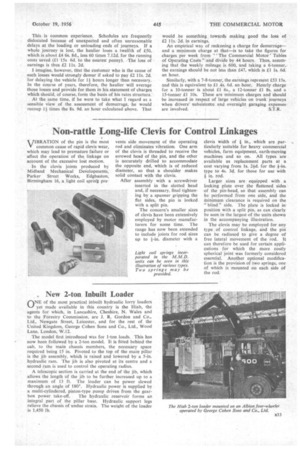Non-rattle Long-life Clevis for Control Linkages
Page 71

If you've noticed an error in this article please click here to report it so we can fix it.
VIBRATION of the pin is the Most common cause of rapid clevis wear, which may lead to premature failure or affect the operation of the linkage on account of the excessive lost motion. In the clevis joints produced by Midland Mechanical Developments, Parker Street Works, Edgbaston, Birmingham 16, a light coil sprig pre vents side movement of the operating rod and eliminates vibration. One arm of the clevis is threaded to receive the screwed head of the pin, and the other is accurately drilled to accommodate the opposite end, which is of reduced diameter, so that a shoulder makes solid contact with the clevis. After assembly with a screwdriver inserted in the slotted head and, if necessary, final tightening by a spanner gripping the flat sides, the pin is locked with a split pin. The concern's smaller sizes of clevis have been extensively employed by motor manufacturers for some time. The range has now been extended to include joints for rod sizes up to 1-in, diameter with a
clevis width of in., which are par
ticularly suitable for heavy commercial vehicles, farm equipment, earth-moving machines and so on. All types are available as replacement parts at a cost varying from Is. 24-d. for the f-in. type to 4s. 3d. for those for use with
in. rod.
Larger sizes are equipped with a locking plate over the flattened sides of the pin-head, so that assembly can be performed from one side, and the minimum clearance is required on the " blind " side. The plate is locked in position with a split pin, as can clearly be seen in the largest of the units shown in the accompanying illustration. The clevis may be employed for any type of control linkage, • and the pin can be radiused to give a degree of free lateral movement of the rod. It can therefore be used for certain applications for which the more costly spherical joint was formerly considered essential. Another optional modification is the provision of two springs, one of which is mounted on each side of the rod.
. New 2–ton Inbuilt Loader
(NE of the most practical inbuilt hydraulic lorry loaders 1.–f yet made available in this country is the Hiab, the agents for which, in Lancashire, Cheshire, N. Wales and to the Forestry Commission, are I. R. Gordon and Co., Ltd., Newgate Street, Leicester, and for the rest of the United Kingdom, George Cohen Sons and Co., Ltd., Wood Lane, London, W.I2. • The model first introduced was for 1-ton loads. This has now been followed by a 2-ton model. It is fitted behind the cab, to the main chassis members, the necessary space required being 15 in. Pivoted to the top of the main pillar is the jib assembly, which is raised and lowered by a 5-in. hydraulic ram. The jib is also pivoted at its centre and a second ram is used to control the operating radius. A telescopic section is carried at the end of the jib, which allows the length of the jib to be further increased up to a maximum of 13 ft. The loader can be power slewed through an angle of 180°. Hydraulic power is supplied by a multi-cylinclered, piston-type pump driVen from the gear box power take-off. The hydraulic reservoir forms an integral part of the pillar base. Hydraulic support legs relieve the chassis of undue strain. The weight of the loader is 1,450 lb.












































































































